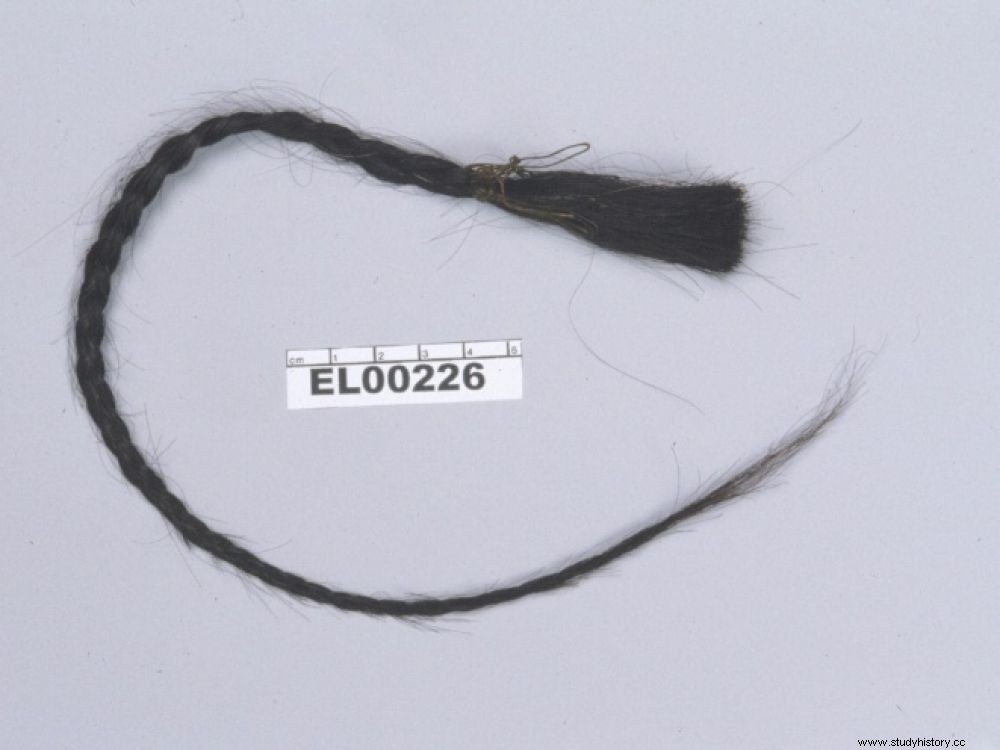For the first time, genetic technology has made it possible to corroborate a relationship between a historical figure and a living descendant, in this case between the famous Native American chief Sitting Bull and a man who claimed to be his great-grandson. /P> 
A braid from the scalp of Native American chief Sitting Bull, in a photo provided by the Department of Anthropology at the Smithsonian Institute in Washington
Thanks to a new technique that allows genetic information to be obtained from a tiny or even fragmented sample of ancient DNA, a relationship between the famous Native American chief Sitting Bull and a living descendant has been established. This technique was developed by a team of scientists led by Prof. Eske Willerslev from the University of Cambridge in the UK, and the Lundbeck Foundation Center for Geogenetics in Denmark. Their findings were published Wednesday in the journal Science Advances .
Previous studies, based on ancient genetic samples, had set out to find matches using genetic sex markers, notably found in the Y chromosome, one of the two gonosomes (or sex chromosomes) of mammals. As a reminder, males have a Y chromosome and an X chromosome, and females have two X chromosomes. Ernie LaPointe, 73, claims to be the descendant of Sitting Bull on the maternal side, Professor Willerslev told AFP, preventing the use of these techniques.
With his fellow researchers, Prof. Willerslev has found a way to look for "autosomal" DNA, that is, non-sexually marked. They located a small amount of autosomal DNA in a sample of Sitting Bull's hair before developing a computer calculation method to compare it with Ernie LaPointe's DNA. "Based on this, we can estimate the relationship to Sitting Bull, " affirmed Prof. Willerslev, adding:"We are 100% certain" that Ernie LaPointe is the great-grandson of Sitting Bull. "

Native American chief Sitting Bull, real name Tatanka-Iyotanka (1831-1890) here in 1885, in a portrait provided by the National Portrait Gallery in Washington (National Portrait Gallery, Smithsonian Institution/AFP - Handout)
Relocate the remains of his ancestor
"Over the years many people have tried to question the relationship my sisters and I have with Sitting Bull, "said Ernie LaPointe in a statement from the University of Cambridge. According to him, the remains of Sitting Bull are currently located in Mobridge, South Dakota, a state that is still home to a large Native American population, in a place that has no resonance with the story of the Lakota chief and the culture he represented. Ernie LaPointe thus sought to establish a genetic link in order to help him obtain the right to exhume his ancestor and transport his remains to a more appropriate place.
Medicine man

Ernie LaPointe, Sitting Bull's great-grandson, in a portrait provided by the National Portrait Gallery in Washington (National Portrait Gallery, Smithsonian Institution/AFP - Handout)
Sitting Bull, whose real name was Tatanka-Iyotanka, was born in 1831 and died in 1890. In 1876, he led 1,500 Lakota warriors at the famous Battle of the Little Big Horn, where they crushed General Custer's American troops.
Nearly 10 years ago, Pr. Willerslev learned of Ernie LaPointe's quest for truth, and offered his services. A hair mat belonging to Sitting Bull and taken after his death was returned by a Washington museum to Ernie LaPointe in 2007, but before he passed it on to Prof. Willerslev he wanted to know if the scientists' intentions were pure. Ernie LaPointe thus asked Eske Willerslev to take part in a ceremony involving a medicine man (function of healer within the Amerindian tribes), percussions, and songs in a darkened room. "A blue-green light appeared in the middle of the room - and I'm a scientist by nature, so I thought, 'well that's the medicine man running around with a lamp', but when I stretched out my arms in the dark, there was no one, said the professor. Eske Willerslev and his hosts then smoked a Lakota pipe, and ate bison meat before Ernie LaPointe informed him that the mysterious light was none other than the spirit of Sitting Bull. , giving his blessing to the study.
Ernie LaPointe, however, only passed down four centimeters of Sitting Bull's mat, which was over 30 centimeters long, and then cremated the rest, as instructed by his ancestor's spirit. "It's a disaster, " Prof. Willerslev thought at the time, considering that he would not have enough DNA left. But circumstances forced him and his team to develop an innovative method over the next 10 years. The same method can now be used to investigate links to other historical figures, from the bandit Jesse James, to the Russian Imperial family...if ancient DNA samples are available.
